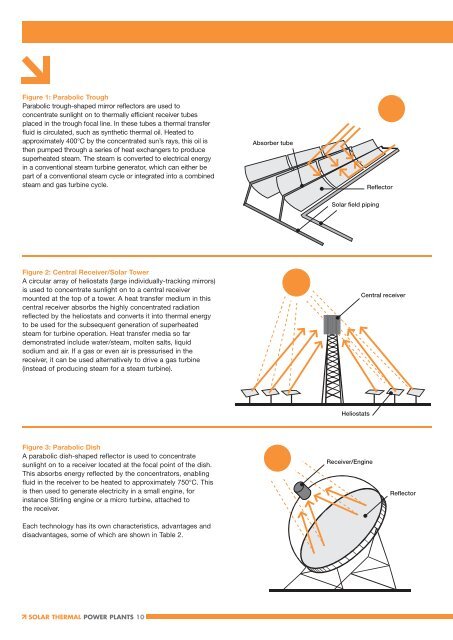solar thermal power - Greenpeace
solar thermal power - Greenpeace
solar thermal power - Greenpeace
Create successful ePaper yourself
Turn your PDF publications into a flip-book with our unique Google optimized e-Paper software.
Figure 1: Parabolic Trough<br />
Parabolic trough-shaped mirror reflectors are used to<br />
concentrate sunlight on to <strong>thermal</strong>ly efficient receiver tubes<br />
placed in the trough focal line. In these tubes a <strong>thermal</strong> transfer<br />
fluid is circulated, such as synthetic <strong>thermal</strong> oil. Heated to<br />
approximately 400°C by the concentrated sun’s rays, this oil is<br />
then pumped through a series of heat exchangers to produce<br />
superheated steam. The steam is converted to electrical energy<br />
in a conventional steam turbine generator, which can either be<br />
part of a conventional steam cycle or integrated into a combined<br />
steam and gas turbine cycle.<br />
Absorber tube<br />
Reflector<br />
Solar field piping<br />
Figure 2: Central Receiver/Solar Tower<br />
A circular array of heliostats (large individually-tracking mirrors)<br />
is used to concentrate sunlight on to a central receiver<br />
mounted at the top of a tower. A heat transfer medium in this<br />
central receiver absorbs the highly concentrated radiation<br />
reflected by the heliostats and converts it into <strong>thermal</strong> energy<br />
to be used for the subsequent generation of superheated<br />
steam for turbine operation. Heat transfer media so far<br />
demonstrated include water/steam, molten salts, liquid<br />
sodium and air. If a gas or even air is pressurised in the<br />
receiver, it can be used alternatively to drive a gas turbine<br />
(instead of producing steam for a steam turbine).<br />
Central receiver<br />
Heliostats<br />
Figure 3: Parabolic Dish<br />
A parabolic dish-shaped reflector is used to concentrate<br />
sunlight on to a receiver located at the focal point of the dish.<br />
This absorbs energy reflected by the concentrators, enabling<br />
fluid in the receiver to be heated to approximately 750°C. This<br />
is then used to generate electricity in a small engine, for<br />
instance Stirling engine or a micro turbine, attached to<br />
the receiver.<br />
Each technology has its own characteristics, advantages and<br />
disadvantages, some of which are shown in Table 2.<br />
Receiver/Engine<br />
Reflector<br />
SOLAR THERMAL POWER PLANTS 10

















